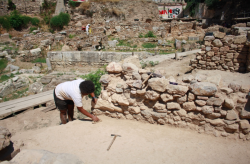Through the Eyes of an Archaeologist

The final day of excavations Summer 2016
What does an excavation look like through the eyes of an archaeologist? To find out we asked several archaeologists and excavators to put a camera on their head as they finished their final day of the summer 2016 excavation season at the Athenian Agora.
The American School of Classical Studies at Athens has been continuously excavating the Ancient Athenian Agora since 1931, uncovering temples, shopfronts, and all sorts of buildings and artifacts from the former center of the city. This summer excavators were working across modern Adrianou Street, in the northwest corner of the ancient square. They believe they are uncovering what is known as the Painted Stoa, a sort of ancient art gallery dated to about 475- 470 BC.
Excavators at the Agora said this summer allowed them to make strides in dating the architecture and using the idig app to record and interpret data. "It’s been a great season for us here," said trench supervisor Nick Seetin "We’re mostly digging Byzantine layers here, and some late Roman in the eastern part of my trench. What surprised me the most was finding these two pythoi. It’s always surprising to me when you’re digging what you think is solid fill and you find a huge hollow in it, a giant container that you can crawl into— two of them!" (One excavator did in fact crawl into one of the pythoi during filming of this video.)
"We've been working in this area for five years now," said archaeologist Melissa Deokaran, working on a nearby trench "And before that they were excavating here for a while. I think at the beginning of the season we were thinking we were almost done with this section and in the last few weeks we’ve had a number of interesting things pop up, and it’s gotten us very excited for the years to come."
"Every season is a totally new experience," said supervisor Daniele Pirsino, "You get to excavate different contexts and therefore you have to have your methodology adapt to the new context you are excavating. It’s absolutely thrilling and diverse."
Read more about excavations at the Agora here.